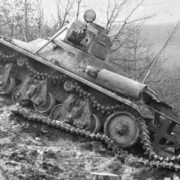The KV-2 was designed to break through fortifications. It had an enormous turret which carried a gigantic 5.98 inch howitzer.
Anti-concrete shells the size of garbage cans were fired from the howitzer. These shells were used to knock down pillboxes and bastions.
As a specialized version of the KV-1, the KV-2 played a role similar to that
Read more
KV-2 Heavy Tank












